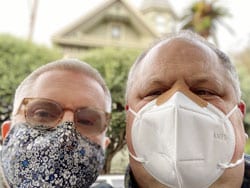En respuesta al anuncio del alcalde Ismael Burgueño Ruiz sobre...
Leer más
For Millions, the Pandemic Is Far From Over: ‘We Are Indeed Stuck’

As much of the country prepares to ditch their masks, mingle more closely, and return to ”normal,” not everyone can board that train.

Connie Taylor
Connie Taylor, 60, from Nashville, is as tired as the next person of the COVID-cautious routines. “It’s getting old,” she said recently. Despite that, she has no plans to ditch her mask, unless she is outdoors with no one in sight, and will continue to social-distance. Taylor was diagnosed with triple negative breast cancer, an aggressive form, in August, and now is getting radiation treatment after having chemotherapy and surgery.

Laura Genoves
Laura Genoves, a family law legal professional in Bainbridge Island, Washington, is also keeping her mask handy and says she will gauge the situation in making the decision to wear it or not. “To be honest, it depends, [but] in an indoor setting with the public I will be wearing my mask.” She takes immunosuppressants to manage her rheumatoid arthritis (RA).

Steve Silberman and husband Keith Karraker
Steve Silberman, a San Francisco science writer and New York Times bestselling author, also continues to be careful. “I have type 2 diabetes, I’m overweight, and I’m 64. My husband takes medicines for psoriatic arthritis.” Silberman’s 84-year-old mother has dementia and is in a nursing facility, which already had a major COVID outbreak.
At least 7 million Americans are immunocompromised due to health conditions or medications — and for them the pandemic isn’t over. Nor is it done for the millions of loved ones they interact with, who must still be vigilant to help protect them.
As multiple Twitter posts suggest, the immunocompromised and those who love them wish the immunocompetent could be mindful and show a little grace and understanding.
Tweeted one woman: “We are indeed stuck.” After explaining that her husband is on RA medications, she is at severe risk, and their kids have health issues too, she puts out the reminder, “We are trying to stay alive, that is all,” while highlighting the challenge they face: “His own parents think we are being ridiculous.”
As the masks have come off for many, there’s been an attitude shift, said Arthur Caplan, PhD, director of the Division of Medical Ethics at NYU Langone Medical Center in New York City. The message from the nonimmunocompromised to the immunocompromised, Caplan said, seems to be, “It’s up to you to protect yourself. Stop asking us to sacrifice for you.” (Caplan is a frequent contributor to Medscape.)
Efforts to Protect the Immunocompromised
The National COVID-19 Preparedness Plan unveiled Wednesday and a ”test to treat” plan discussed during the State of the Union (SOTU) address Tuesday both include the need to prioritize protections for the immunocompromised.
While that represents good progress, it doesn’t go far enough, advocates for the immunocompromised said. And several tweets took issue with the actions, claiming it is basically throwing the immunocompromised under the bus. Read one: “The immunocompromised and vulnerable have been abandoned. Again.”
The preparedness plan says it promises ”strong support for the immunocompromised, including providing prioritized access to treatments and preventive interventions — pending additional funding from Congress — as well as ensuring access to boosters.”
During SOTU, President Biden announced a ”test to treat” announcement, promising availability of COVID treatments on the spot when someone tests positive.
While more testing and treatment are both welcomed, the availability of treatment ”is still pretty rare,” said Mia Ives-Rublee, MSW, director of the Disability Justice Initiative at the Center for American Progress, a nonpartisan policy institute.
Another issue: ”It makes pharmacies even more dangerous for the immunocompromised,” she said. The Biden administration said it expects to open hundreds of these one-stop shops in March at pharmacies, community health centers, and other sites.
Another problem for the immunocompromised is relying on the recently relaxed guidance from the Centers for Disease Control and Prevention (CDC) for masking, Ives-Rublee said. It takes into account new hospitalizations, current hospital beds occupied by COVID patients, or capacity, and new cases.
“When [community levels] are low to medium [with no strain on healthcare systems], the responsibility is on the individual to keep themselves safe,” she said.
On March 3, the CDC, using those new metrics for measuring the threat of COVID-19, said that more than 90% of people in the United States generally don’t need to wear face masks anymore.
On the very same day, representatives from more than 100 organizations advocating for the rights of the disabled, the elderly, children with special needs, and others, sent a letter to CDC Director Rochelle Walensky, MD, MPH, asking for a change to the new guidance: “We urge the CDC to revise the new guidance to address the needs of high risk people and recommend that everyone wear N95s or the highest quality masks available in indoor public settings including schools,” they write.
A set of reforms for nursing homes, where many residents are immunocompromised, was announced in late February and involves making sure staff is adequate in numbers and trained, among other measures, Ives-Rublee said. Additional measures could help even more, she said, such as requiring N95 masks, not just any mask, at all medical facilities.
”School systems should also create guidance for masking and support for individuals who may not be able to go [in person] whether they are immunocompromised themselves or a family member is,” Ives-Rublee said.
A higher degree of coordination between the US Department of Education and the White House in looking at best practices in schools would also improve things, she said.
The Risk Is Real
Experts have long known that COVID vaccines don’t produce the same levels of antibodies in those who are immunocompromised whether from conditions or from medications used to treat those conditions.
Sometimes an immunocompromised person isn’t even able to get vaccinated, said Karen E. Knudsen, MBA, PhD, chief executive officer of the American Cancer Society (ACS) and its advocacy affiliate, the American Cancer Society Cancer Action Network.
“We have 1.9 million new [cancer] diagnoses a year,” Knudsen said. “Someone undergoing active treatment is often immunocompromised and may not even have been eligible for a vaccine. Those who were eligible may not have gotten the entire benefit. We would call them under-vaccinated individuals.”
COVID occurs even if vaccination is possible. The CDC now estimates that up to 44% of breakthrough COVID infections in hospitalized patients are in the immunocompromised category.
In one study in JAMA Internal Medicine, researchers evaluated more than 664,000 patients who had gotten at least one dose of a COVID vaccine and found that those with immune dysfunction had a higher rate of breakthrough infections and worse outcomes after partial or full vaccination compared with those without immune issues.
“The vaccine response was just not working as well in these immunocompromised [people],” said lead author Jing Sun, MD, MPH, PhD, assistant scientist at the Johns Hopkins Bloomberg School of Public Health in Baltimore, Maryland.
“We also observed that in the general population if you have a breakthrough, you are usually in the more mild [category]. But people in the immunocompromised [category] could still get pretty sick.” Those with HIV, solid organ transplants, and RA were especially found to have an elevated risk for breakthrough infections, Sun said.
Advocacy by Other Organizations
Besides the new national focus on the immunocompromised, organizations representing those who are immunocompromised continue to press for protections. The American Cancer Society has recommended that all healthcare providers work with cancer patients to educate them about the risk for COVID for them.
“We have had educational outreach in many channels, including social media, to raise awareness of the disproportionate risk of contracting COVID [if immunocompromised, and to take every possible precaution,” the ACS’ Knudsen said.
The Arthritis Foundation continues to push for more access to telehealth, especially for those who are immunocompromised, said Anna Hyde, a foundation spokesperson. The foundation has also monitored shortages of COVID medications, she said, contacting manufacturers and the US Food and Drug Administration, and keeping patients updated about shortages.
A national approach must ”continue to use and invest in widespread testing,” said Jorey Berry, president and CEO of the Immune Deficiency Foundation, which advocates for those born with primary immunodeficiencies, often due to genetic causes.
Like others, the foundation expressed concern about the new CDC monitoring guidance. “Less reliance on transmission metrics [as recommended in new guidelines] will likely lead to a decrease in testing, which will limit our ability to predict when new waves of infection are coming, making [immunocompromised] communities more vulnerable,” Berry said.
A Mostly Mask-Free World
Immunocompromised patients say they have found ways to reduce risk and extract some understanding from others. Taylor tries to visit stores during nonpeak hours. At the pandemic’s beginning, many stores offered special hours for older adults and those at risk, but now some stores have eliminated those.
Even during nonpeak hours, Taylor finds some people getting too close, especially at checkouts. She’s polite but firm. “Excuse me, if you could step back” usually works. That might also be because of her appearance, she said. “They can look at me and tell I’m a cancer patient” due to hair loss.
After Genoves, who has RA, got the recommended fourth shot, someone questioned her decision. She’s learned to reply simply and move on. She told that person: “You know, everyone makes their own choices.” Then she stays quiet.
Silberman’s solution is to stay vocal. “I’ll keep wearing masks, keep posting photos of myself wearing masks and I will keep pointing out the dangers to vulnerable populations like my mother.” Still, he remembers previous times, when he says people would think more about ”the good of the whole.”
Sometimes, that thinking resurfaces. When Brigham Young University dropped the mask mandate, Melissa Alcaraz, an assistant sociology professor there, emailed her class, asking them to keep masking up to help her protect immunocompromised loved ones. She was pleasantly surprised when she got to class. They all did.
Asking people to help you stay safe, instead of ranting at their selfishness, can work, said Leonard Jason, PhD, a professor of community and clinical psychology at DePaul University in Chicago, Illinois. “When you ask people for help, it’s sort of disarming and it makes them more willing. You aren’t trying to control them.” You are simply asking for help. Even so, the conversation may have to be ongoing, and the approach won’t work with the insensitive, he said.
“Asking others to help you is still morally fine and I would not hesitate to do that among your immediate circle,” Caplan said.
When visiting another household, or if your children are, ”I think everyone should ask, ‘Are there immunocompromised people in your house?”’ and then take the precautions form there, Caplan said. “It’s like asking about a peanut allergy.”
While the immunocompromised may feel they have little control over how their community is responding to the pandemic, ”they have control over how they talk about it,” said Shannon La Cava, PsyD, a clinical psychologist and chief clinical officer of Cancer Support Community Los Angeles, part of a national network providing help for people living with cancer. Put the focus there, she advised.
If they get pushback about continuing to mask up, having a go-to response might make things easier. “Oh, I am just following doctor’s orders” might work, she said. Or use humor, such as “This mask takes off 20 years. I’m not giving it up.”
https://www.medscape.com/viewarticle/969716?src=soc_fb_220306_mscpedt_news_mdscp_covid&faf=1#vp_1
Créditos: Comité científico Covid




